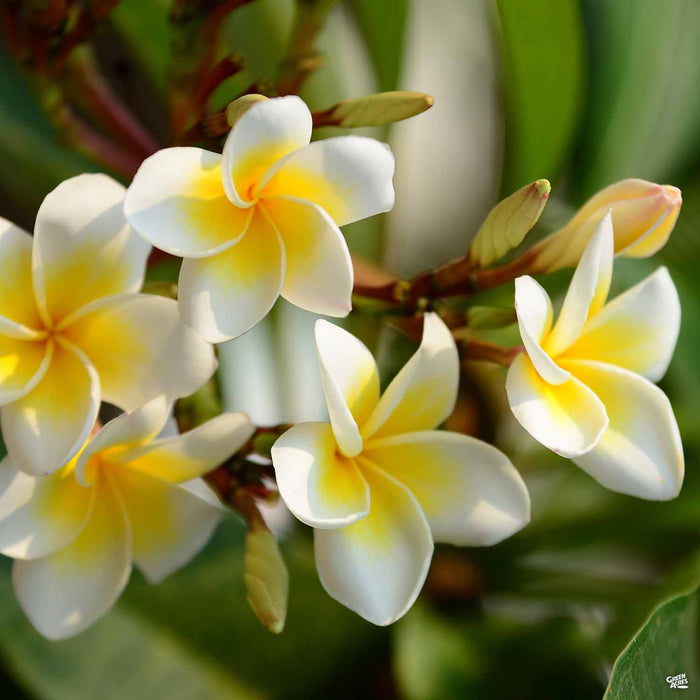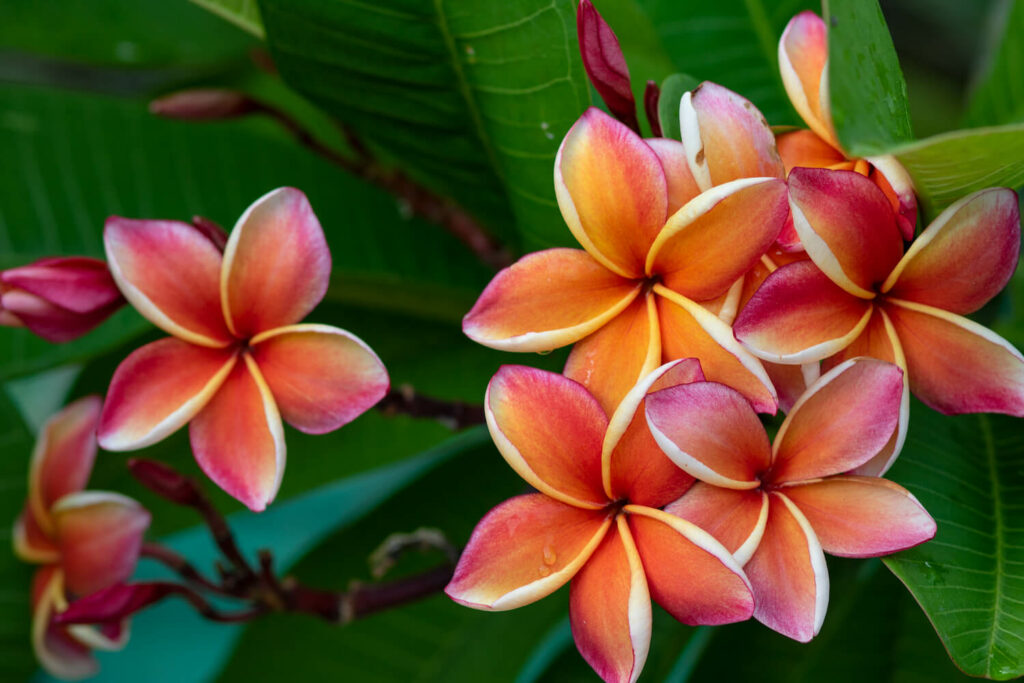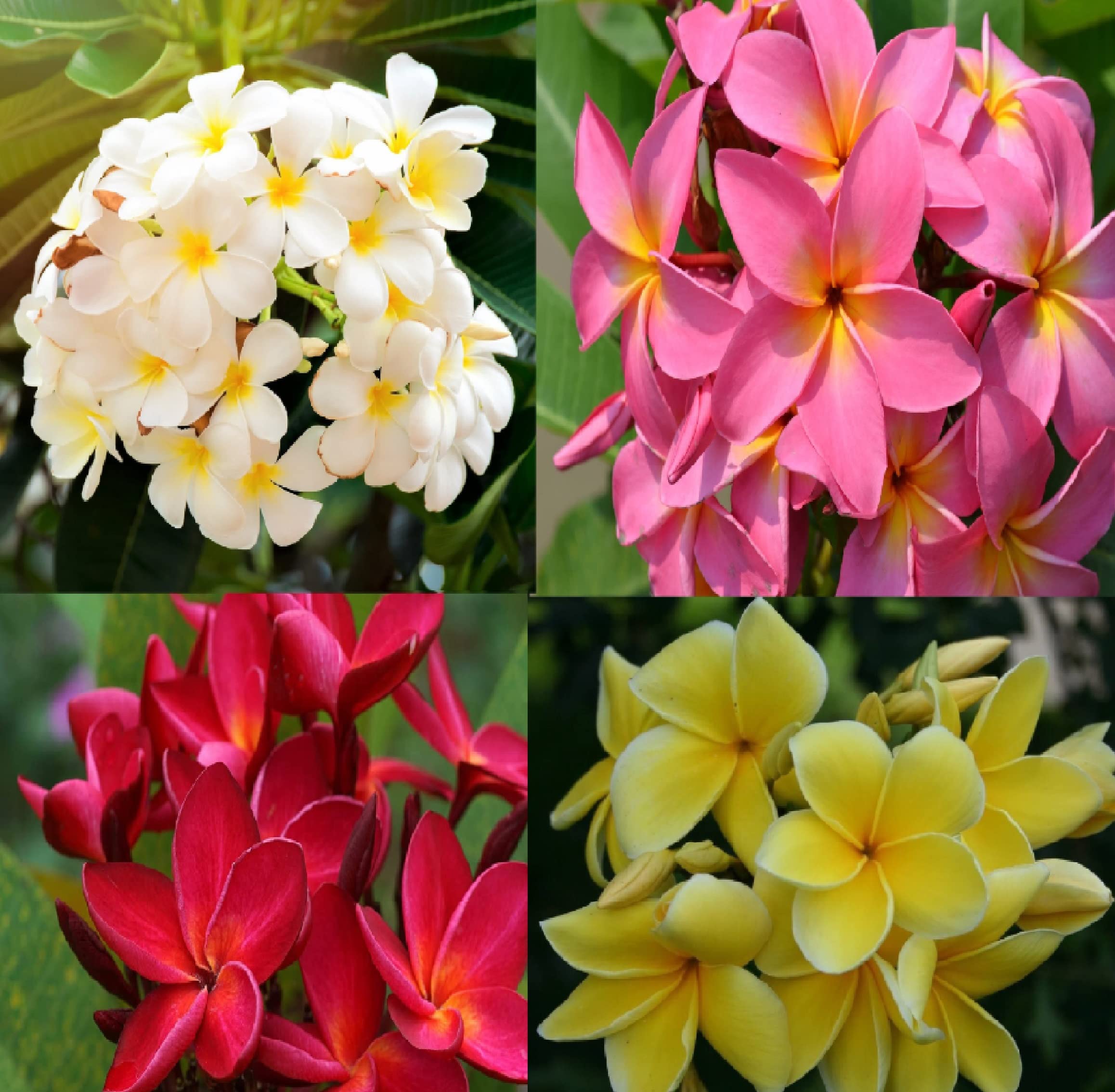Plumeria, also known as frangipani, is a tropical flower that is highly revered for its beauty and fragrance. It is native to Central America, Mexico, and the Caribbean, but has now spread to other parts of the world due to its popularity. While it may seem like just another pretty flower, plumeria actually holds a deep meaning and symbolism in various cultures and traditions. In this article with Impeccable Nest, we will delve into the rich history and significance of plumeria, and explore how it is used and perceived in different contexts.

Plumeria Meaning: in Different Cultures
As mentioned earlier, plumeria holds different meanings in different cultures. Here are some examples of how plumeria is used and perceived in various traditions:
In Hawaiian Culture
Plumeria, also known as frangipani, is a beautiful and fragrant flower that holds great significance in the Hawaiian culture. It is not just a flower, but a symbol of love and beauty that is deeply rooted in the traditions and customs of the island.
In Hawaii, plumeria is commonly associated with love and is often used in traditional ceremonies to honor loved ones. One of the most significant occasions where plumeria is used is during weddings. The flower is considered a symbol of new beginnings, purity, and devotion, making it a perfect choice for wedding ceremonies. Brides often wear plumeria leis or have them incorporated into their bouquets as a way to express their love and commitment to their partner.
Apart from weddings, plumeria is also an essential part of funerals in Hawaii. The flower is believed to represent the soul’s journey to the afterlife, and its sweet fragrance is said to guide the departed on their journey. Plumeria leis are often placed on the casket or given to mourners as a way to honor and remember the deceased.
In addition to these significant life events, plumeria is also used in everyday life in Hawaii as a way to show respect and affection. It is a common practice to give plumeria leis as a gift to friends, family, or even strangers as a sign of appreciation and friendship. The act of giving and receiving plumeria leis is seen as a gesture of aloha, which means love, compassion, and peace.
The use of plumeria in Hawaiian culture goes beyond its physical beauty and pleasant fragrance. It holds deep spiritual and cultural significance, representing love, beauty, and connection. The flower’s five petals are said to symbolize the five elements of nature – earth, water, fire, air, and spirit – making it a powerful and sacred symbol in Hawaiian beliefs.
Plumeria is much more than just a flower in Hawaii. It is a symbol of love, beauty, and connection that holds great importance in the island’s traditions and customs. Whether it is used in ceremonies, given as a gift, or simply admired for its beauty, plumeria is an integral part of Hawaiian culture and will continue to be cherished and celebrated for generations to come.
In Indian Culture
Plumeria, also known as frangipani, is a beautiful and fragrant flower that holds great significance in Indian culture. It is commonly associated with the goddess of wealth and prosperity, Lakshmi, and is often used in religious rituals and offerings.
In Hindu mythology, Lakshmi is the goddess of wealth, fortune, and prosperity. She is believed to bring good luck and blessings to those who worship her. Plumeria, with its vibrant colors and sweet fragrance, is considered to be a symbol of her divine presence and is thus closely associated with her.
The use of plumeria in religious rituals can be traced back to ancient times in India. The flower is considered sacred and is often used in various ceremonies and pujas (worship rituals). It is believed that offering plumeria garlands to deities during prayers and ceremonies brings good fortune and blessings from Lakshmi.
Apart from its association with Lakshmi, plumeria also holds significance in other religious practices in India. In Hinduism, it is believed that Lord Vishnu, one of the major deities, rests on a bed of plumeria flowers in his celestial abode. Therefore, the flower is also considered to be auspicious and is often used in offerings to Lord Vishnu.
In addition to its religious significance, plumeria is also highly valued for its medicinal properties in Ayurveda, the traditional system of medicine in India. Its leaves, bark, and flowers are used to treat various ailments such as skin diseases, fever, and inflammation. The oil extracted from the flowers is also used in aromatherapy to promote relaxation and reduce stress.
The use of plumeria in religious rituals and offerings is not limited to Hinduism. In Buddhism, the flower is also considered sacred and is often used in offerings to Buddha. It is believed that the white plumeria symbolizes purity and the yellow plumeria represents enlightenment.
In India, plumeria garlands are commonly used in weddings, festivals, and other auspicious occasions. The flower is also a popular choice for decorating homes and temples during special celebrations. Its presence is believed to bring positivity, happiness, and prosperity to the household.
Plumeria holds great cultural and religious significance in India. It is closely associated with the goddess of wealth and prosperity, Lakshmi, and is believed to bring blessings and good fortune. The use of plumeria in religious rituals and offerings is a form of devotion and is deeply ingrained in Indian culture. Its beauty, fragrance, and medicinal properties make it a cherished flower in the country, and its association with Lakshmi adds to its spiritual value.

In Thai Culture
In Thailand, plumeria holds a special significance and is deeply ingrained in the culture and traditions of the country. The flower is commonly known as “Lan Dok Mai” in Thai, which translates to “flower that blooms in the month of May”. This name is derived from the fact that plumeria flowers typically bloom during the month of May in Thailand.
One of the most significant associations of plumeria in Thailand is with the god of love, Kama. In Hindu mythology, Kama is the god of desire, love, and pleasure. He is often depicted as a handsome young man wielding a bow and arrow, which he uses to strike the hearts of mortals and make them fall in love. Plumeria is believed to be the favorite flower of Kama, and it is said that the flower represents his beauty, charm, and power of attraction.
Due to this association with Kama, plumeria is often used in wedding ceremonies in Thailand. It is seen as a symbol of love, commitment, and devotion between the bride and groom. The flower is used in various ways during the wedding rituals, such as adorning the bride’s hair, making garlands for the couple, or decorating the wedding venue. Plumeria is also considered to bring good luck and blessings to the newlyweds, ensuring a happy and prosperous marriage.
Apart from its symbolic significance in weddings, plumeria also has medicinal properties and is used in traditional Thai medicine. The flower is believed to have anti-inflammatory, antiseptic, and analgesic properties, making it useful in treating various ailments. In traditional Thai medicine, plumeria is used to treat skin conditions, respiratory problems, and digestive issues. The leaves and bark of the plumeria tree are also used to make herbal remedies for different health problems.
In addition to its cultural and medicinal importance, plumeria is also highly valued for its beauty and fragrance. The flower comes in a variety of colors, including white, yellow, pink, and red, and each color has its own symbolic meaning. White plumeria is associated with purity and innocence, while yellow represents friendship and happiness. Pink symbolizes romance and love, and red is often used to express passion and desire.
Plumeria holds a special place in Thai culture and traditions. Its association with the god of love, Kama, makes it a popular choice for weddings and other romantic occasions. Its medicinal properties also make it a valuable ingredient in traditional Thai medicine. And its beauty and fragrance continue to captivate people, making it a beloved flower in Thailand.
Plumeria Meaning: What Does It Represent?
Plumeria is a highly symbolic flower, with each color and variety holding a unique meaning. Here are some of the most common interpretations of plumeria’s symbolism:
Love and Romance
Plumeria, also known as frangipani, is a tropical flower that is native to Central America, Mexico, and the Caribbean. It is a small tree or shrub with thick, leathery leaves and large, fragrant flowers in shades of white, yellow, pink, and red. The name “plumeria” comes from the French botanist Charles Plumier, who first described the flower in the 17th century.
The most commonly known meaning of plumeria is love and romance. Its delicate petals and sweet fragrance make it a popular choice for bouquets and floral arrangements, especially for weddings and anniversaries. In fact, plumeria is often referred to as the “flower of love” or the “flower of devotion.” This is because the flower’s beauty and intoxicating scent are said to symbolize the intense emotions of love and passion.
In Hawaiian culture, plumeria holds a special significance and is often given as a gift to express one’s love and affection. In the Hawaiian language, plumeria is called melia, and it is considered a sacred flower that represents perfection and positivity. It is also associated with the goddess Pele, who is known as the goddess of fire, lightning, wind, and volcanoes. Plumeria is often used in traditional Hawaiian ceremonies and rituals, such as weddings, funerals, and blessings.
Apart from its association with love and romance, plumeria also has other meanings and symbolism. In some cultures, the flower is seen as a symbol of new beginnings and birth. This is because plumeria trees can grow from cuttings, which represent new life and growth. In Hindu mythology, the plumeria flower is associated with the god Vishnu and is believed to bring good luck and prosperity.
Additionally, plumeria is also associated with beauty and charm. Its vibrant colors and sweet fragrance make it a popular choice for adornment and decoration. In some cultures, the flower is also believed to have healing properties and is used in traditional medicine to treat various ailments.
In conclusion, plumeria holds a special place in many cultures and is more than just a beautiful flower. Its delicate petals, intoxicating scent, and rich symbolism make it a beloved flower that represents love, romance, beauty, and new beginnings. Whether given as a gift or used in ceremonies and rituals, plumeria will always hold a special meaning and continue to bring joy and happiness to those who encounter it.
Beauty and Charm
Plumeria, also known as frangipani, is a tropical flower that is native to Central America, Mexico, and the Caribbean. It is widely recognized for its stunning appearance, with its vibrant colors and elegant shape making it a popular choice for adornments such as hair accessories and jewelry. However, beyond its physical beauty, plumeria also holds significant meaning and symbolism in various cultures.
One of the most common meanings associated with plumeria is its representation of beauty and charm. Its delicate petals and sweet fragrance have captured the hearts of many, making it a beloved flower in gardens and bouquets. In Hawaiian culture, plumeria is known as “melia,” which means gentle and lovely. This name perfectly encapsulates the essence of this flower, as it exudes a sense of grace and elegance.
In addition to its association with physical beauty, plumeria also holds symbolic meaning in terms of inner beauty. The flower’s five-petal structure is often seen as a representation of the five human senses – sight, smell, touch, taste, and hearing. This symbolism suggests that true beauty lies not only in one’s physical appearance but also in their ability to appreciate and engage with the world around them.
Moreover, plumeria is believed to possess magical powers that can enhance one’s physical attractiveness. In some cultures, it is used in love spells or charms to attract a romantic partner or enhance one’s existing relationship. This belief may stem from the flower’s alluring appearance and enchanting fragrance, which are thought to have a hypnotic effect on those who come into contact with it.
Aside from its associations with beauty and charm, plumeria also holds cultural significance in various parts of the world. In Hinduism, the flower is considered sacred and is often used in religious ceremonies and offerings to deities. In Bali, plumeria is used in traditional wedding ceremonies as a symbol of love, loyalty, and devotion. In Mexico, the flower is associated with the Day of the Dead festival, where it is used to decorate altars and graves as a way to honor and remember loved ones who have passed away.
In conclusion, plumeria’s stunning appearance has not only made it a popular choice for adornments but has also led to its association with beauty and charm. Its vibrant colors and elegant shape make it a symbol of physical and inner beauty, while its magical powers are believed to enhance one’s attractiveness. Additionally, plumeria holds cultural significance in various parts of the world, making it a beloved and cherished flower that goes beyond its aesthetic appeal.
New Beginnings and Transformation
Plumeria, also known as frangipani, is a beautiful and fragrant flower that holds deep symbolism in many cultures around the world. This tropical flower is native to Central America, Mexico, and the Caribbean, but has become popular in other regions due to its stunning appearance and symbolic meaning.
One of the most common meanings associated with plumeria is new beginnings and transformation. The flower blooms in the spring, which is often seen as a time of renewal and growth. Its vibrant colors and delicate petals represent the beauty and potential of new opportunities and experiences. In this way, plumeria is often given as a gift to someone who is starting a new chapter in their life, such as graduating from school, getting married, or moving to a new place.
In addition to new beginnings, plumeria is also associated with rebirth and growth. This is because the flower goes through a cycle of blooming and shedding its leaves throughout the year. This process symbolizes the natural cycles of life, death, and rebirth. As such, plumeria can be seen as a reminder to embrace change and let go of the past in order to grow and evolve.
The significance of plumeria can also vary depending on its color. White plumeria is often associated with purity, innocence, and spirituality. It is commonly used in wedding ceremonies and other religious rituals. Pink plumeria, on the other hand, represents love, romance, and affection. It is often given as a gift to express one’s feelings towards another person. Yellow plumeria symbolizes happiness, joy, and friendship. It is a popular choice for gifts among friends and loved ones.
In some cultures, plumeria is also believed to have healing properties. Its sweet fragrance is said to have a calming effect on the mind and body, making it a popular ingredient in aromatherapy. The flower is also used in traditional medicine to treat various ailments, such as skin irritations and inflammation.
Overall, plumeria holds a special place in many cultures as a symbol of new beginnings, transformation, and growth. Its beauty and fragrance make it a meaningful gift for any occasion, whether it be a celebration or a time of change. So the next time you come across a plumeria, take a moment to appreciate its symbolic meaning and the powerful message it carries.

Plumeria Meaning: Color Variations
Beyond the rich cultural history, the variety of plumeria blooms also carry their own unique symbolic associations:
White Plumeria Flowers
White plumeria flowers, also known as frangipani, are a type of tropical flower that holds significant symbolism in many cultures around the world. These beautiful flowers are often associated with purity, enlightenment, rebirth, and new beginnings. In this essay, we will explore the various meanings and cultural significance of white plumeria flowers.
One of the most common meanings associated with white plumeria flowers is purity. The pristine white color of these flowers represents innocence and cleanliness. It is believed that these flowers have the power to purify one’s mind and soul, making them a popular choice for spiritual and religious ceremonies. In Hinduism, for example, white plumeria flowers are offered to deities as a symbol of devotion and purity.
In addition to purity, white plumeria flowers also symbolize enlightenment. This meaning is derived from the fact that these flowers bloom at night and release a strong, sweet fragrance. This process of blooming in darkness and spreading their fragrance can be seen as a metaphor for achieving enlightenment through inner reflection and self-discovery. In some cultures, these flowers are used in meditation practices to help individuals reach a state of calmness and clarity.
Another important symbolism associated with white plumeria flowers is rebirth and new beginnings. This meaning is closely tied to the fact that these flowers bloom in the spring, signaling the start of a new season and the renewal of life. In many cultures, white plumeria flowers are given as gifts to celebrate new beginnings such as graduations, new jobs, or moving to a new home. They are also commonly used in funeral arrangements as a way to honor the deceased and symbolize their journey into a new life.
In some Eastern cultures, white plumeria flowers hold a special significance in spirituality. In Buddhism, these flowers are considered sacred and are often used in religious rituals and offerings. They are also associated with the concept of impermanence, reminding individuals to embrace the present moment and let go of attachments. In Japan, white plumeria flowers are known as “the flower of death” and are often planted near graveyards as a symbol of the cycle of life and death.
White plumeria flowers are also commonly used in wedding ceremonies, especially in Hawaiian and Polynesian cultures. These beautiful flowers symbolize new love and the beginning of a new chapter in a couple’s life together. They are often worn as hair accessories or used in bouquets and decorations, adding a touch of elegance and symbolism to the special day.
White plumeria flowers hold deep cultural significance and symbolism in many parts of the world. Their pure white color, delicate fragrance, and blooming process make them a powerful symbol of purity, enlightenment, rebirth, and new beginnings. Whether used in religious ceremonies, meditation practices, or special occasions, these flowers serve as a reminder to embrace the beauty and impermanence of life.
Pink Plumeria Flowers
Pink plumeria flowers, also known as frangipani, are a type of tropical flower that is closely associated with romantic love in Western cultures. These beautiful flowers have a rich history and cultural significance, making them a popular choice for weddings, special occasions, and even as gifts for loved ones.
In Western cultures, pink plumeria flowers are often seen as symbols of love, passion, and devotion. This is due to their delicate appearance and sweet fragrance, which has long been associated with romance and affection. In fact, these flowers are commonly used in wedding bouquets and decorations, as they are believed to bring good luck and happiness to the newlyweds.
Aside from their association with romantic love, pink plumeria flowers also hold great spiritual significance in other cultures. In Hinduism, these flowers are considered sacred to the deity Krishna, who is often depicted wearing them in his hair. This is because the fragrant scent of the flowers is said to be pleasing to the gods, and offering them to Krishna is believed to bring blessings and protection.
In Buddhism, pink plumeria flowers are also highly revered and are often used in religious practices to encourage compassion and kindness. The flowers are believed to symbolize purity and enlightenment, and their delicate beauty serves as a reminder to practitioners to cultivate inner peace and harmony.
Aside from their cultural and spiritual significance, pink plumeria flowers also have a wide range of practical uses. The fragrant oil extracted from the flowers is commonly used in perfumes, soaps, and aromatherapy products due to its calming and uplifting properties. The flowers themselves can also be used to make garlands, leis, and other decorative items, adding a touch of tropical charm to any occasion.
Pink plumeria flowers are not just beautiful blooms, but they also hold deep cultural and spiritual meanings. From symbolizing romantic love in Western cultures to being sacred to Hindu and Buddhist deities, these flowers have captured the hearts of people all over the world. Whether used for their practical purposes or as a symbol of love and devotion, pink plumeria flowers will continue to hold a special place in our hearts and cultures for years to come.

Yellow Plumeria Flowers
Yellow plumeria flowers are known for their vibrant and cheerful color, which evokes feelings of joy, positivity, and friendship. The bright yellow hue of these flowers is often associated with the sun, which is seen as a source of warmth, light, and happiness. This makes yellow plumeria flowers a popular choice for bouquets and arrangements, as they can instantly brighten up any space and bring a sense of happiness to those who see them.
In some Eastern religions, yellow plumeria flowers hold a deeper meaning and are often used as symbols of spiritual devotion. In Hinduism, for example, the yellow plumeria flower is associated with the goddess Kali, who is believed to be the embodiment of divine energy and power. The flower is often offered to her as a sign of devotion and gratitude, and it is believed that by doing so, one can attain spiritual enlightenment and inner peace.
Apart from its spiritual significance, yellow plumeria flowers are also seen as representing creativity and inner light. The bright yellow color of these flowers is often associated with the solar plexus chakra, which is believed to be the center of creativity and personal power. It is believed that by surrounding oneself with yellow plumeria flowers, one can tap into their creative potential and unleash their inner light.
In addition to their symbolic meanings, yellow plumeria flowers are also highly valued for their beauty and fragrance. These flowers have a unique shape, with five petals arranged in a spiral pattern, giving them a delicate and elegant appearance. Their sweet and intoxicating scent is often used in perfumes and essential oils, making them a popular choice for aromatherapy and relaxation.
Yellow plumeria flowers are more than just beautiful blooms. They hold deep symbolic meanings and are highly valued for their ability to evoke positive emotions and energies. Whether used in religious ceremonies, as a symbol of creativity, or simply to brighten up a room, these flowers are sure to bring joy and positivity to those who encounter them.
Red Plumeria Flowers
Red plumeria flowers are known for their vibrant color and beautiful appearance. They hold a special significance in many cultures around the world, representing various aspects of life and love. In this article, we will explore the different meanings associated with red plumeria flowers.
Firstly, red plumeria flowers are often connected to life and vitality. This is due to their bright red color, which symbolizes energy and passion. The vibrant hue of these flowers is believed to represent the life force energy that flows through all living beings. In some cultures, red plumeria flowers are seen as a reminder to live life to the fullest and embrace our passions and desires.
In addition to this, red plumeria flowers are also strongly associated with romantic love, particularly in China and Japan. These flowers are often given as gifts to express deep feelings of love and affection towards someone. In Chinese culture, red plumeria flowers are seen as a symbol of commitment and devotion, making them a popular choice for wedding bouquets and decorations. Similarly, in Japan, these flowers are often used in traditional wedding ceremonies as a representation of the strong bond between two people.
Furthermore, red plumeria flowers hold a special significance in Hawaiian customs. In Hawaiian culture, these flowers are known as “melia” and are considered sacred. They are often used in traditional ceremonies and rituals, where they are seen as a representation of the blood of life. This is because the red color of the flowers is believed to symbolize the life-giving properties of blood. Red plumeria flowers are also commonly used in leis, which are worn around the neck or head as a symbol of love, respect, and honor.
Red plumeria flowers hold a deep and meaningful symbolism in various cultures around the world. They represent life, passion, and vitality, and are often associated with romantic love and devotion. Their vibrant color and delicate appearance make them a popular choice for gifts and decorations, and their cultural significance adds an extra layer of meaning to these beautiful flowers. Whether given as a gift or used in traditional ceremonies, red plumeria flowers are sure to evoke feelings of love, passion, and vibrancy.
In Conclusion
Plumeria is a flower that has captured the hearts of people all over the world with its beauty and fragrance. But beyond its physical attributes, plumeria holds a deeper meaning and symbolism in various cultures. Whether you’re looking to add some tropical flair to your garden or seeking a meaningful gift for a loved one, plumeria is a perfect choice that will bring joy and positivity into your life.

We’re Emma Carole Paradis and Kimberly Carole, the owners and designers of Impeccable Nest, based in Bedford, New Hampshire. A mother-daughter team with a love of design. Originally from Manhattan Beach, California, now based in Bedford, New Hampshire, we bring a Southern California cool and New England tradition to our design. Not only do we work together…we also live together in a multi-generational home…and a home that they are known to design for others.
